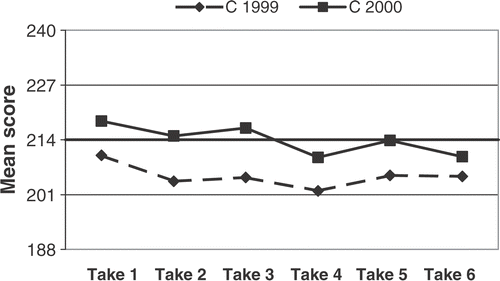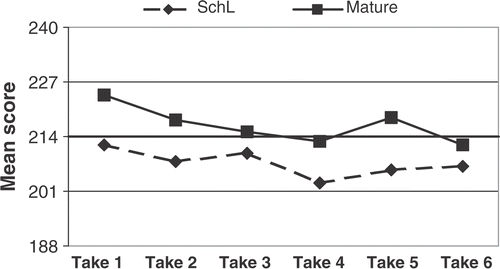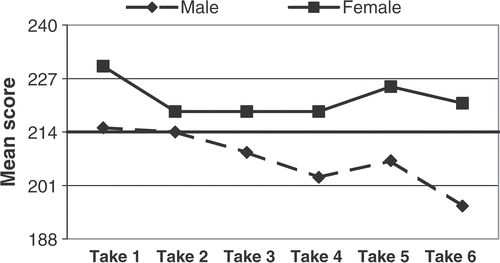Figures & data
Figure 1. Change in whole cohort perceived SDLR over year 1. A significant change occurred over time (p = 0.00) with all cohorts responding similarly (p = 0.14). (Admission data = Take 1, End year 1 data = Take 2; Bold line indicates mean score for similar samples, Guglielimino, Citation1977.)

Figure 2. Change in whole cohort perceived SDLR over the three-year programme. A significant change occurred over time (p = 0.008) with both cohorts responding similarly (p = 0.64). (Admission data = Take 1, End year 1 data = Take 2; Beginning year 2 data = Take 3, End year 2 data = Take 4; Beginning year 3 data = Take 5; End year 3 data = Take 6. Bold line indicates mean score for similar samples, Guglielimino, Citation1977).

Table 1. Summary of data collection tools. In all cases the higher the score the greater the variable is perceived to be held
Figure 3. Change in perceived SDLR over the three-year programme defining by admission age. A significant change occurred over time (p = 0.002) with both groups responding similarly (p = 0.431). There was a significant age effect (p = 0.016). (Admission data = Take 1, End year 1 data = Take 2; Beginning year 2 data = Take 3, End year 2 data = Take 4; Beginning year 3 data = Take 5; End year 3 data = Take 6. Bold line indicates mean score for similar samples, Guglielimino, Citation1977.)

Table 2. Change in variable scores over 3 years profiling for admission age. Values reflect p-values obtained from a repeated-measures ANOVA with a first-order polynomial contrast
Figure 4. Change in the perceived SDLR of mature students over the three-year programme. A significant change occurred over time (p = 0.045) with both groups responding similarly (p = 0.3). There was a significant gender effect (p = 0.022). (Admission data = Take 1, End year 1 data = Take 2; Beginning year 2 data = Take 3, End year 2 data = Take 4; Beginning year 3 data = Take 5; End year 3 data = Take 6. Bold line indicates mean score for similar samples, Guglielimino, Citation1977).

Table 3. Variable mean scores on admission (Take 1), at the end of Year 1 (Take 2) and at the end of Year 3 (Take 6) of the mature student study sample (Female n = 25, male n = 14)
Table 4. The difference between female and male variable score at Take 6. In all cases the more mature profile is displayed by the mature female group
Table 5. Comparison of learning profiles: ‘Ideal’ autonomous professional versus mature, male undergraduates at the end of year 3. The p-values reflect the change in matched variable mean scores from Take 1 to Take 6
Table 6. Mean final year assessment scores for mature students by gender. The clinical placement scores were not included in the degree classification calculations for the 1997-validated programme